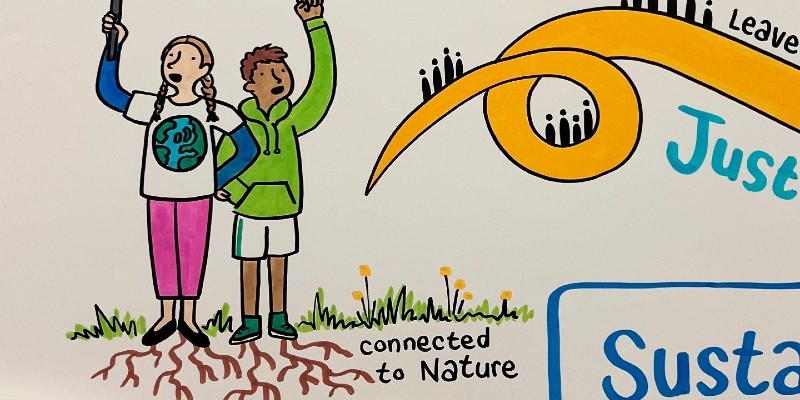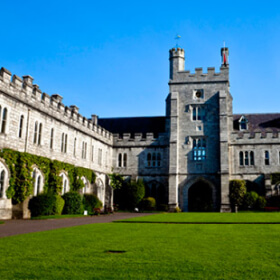Blog
Nondiscrimination/Equality and Children’s Rights in the Climate Crisis

Youth climate justice project PI Prof Aoife Daly has a new book chapter out entitled 'Nondiscrimination/Equality and Children's Rights in the Climate Crisis'. You can read it here.
Youth climate justice project PI Prof Aoife Daly has a new book chapter out entitled 'Nondiscrimination/Equality and Children’s Rights in the Climate Crisis'. It's part of a book that she has edited together with colleagues from Stockholm university (Prof Pernilla Leviner) and Uppsala university (Rebecca Thorburn Stern) - Treated Like a Child: Age Discrimination and Children’s Rights (Brill, 2025). This book brings together experts to consider issues related to discrimination against children, relating to e.g. child labour, migration, and healthcare. Attention is drawn to the potential to advance children’s rights in the framework of nondiscrimination in relation to children as a group.
Aoife's chapter examines how children are active agents who are leading efforts to combat climate change. The UNCRC has generally not resulted in explicit consideration of age discrimination against children (i.e. detrimental treatment for being young/under 18) in the same way that has happened for other groups like women and ethnic minorities. Yet there is potential for doing so, primarily through crc Article 2. Child/youth climate petitions (e.g. the Duarte Agostinho – ‘Portuguese youth’ – petition to the European Court of Human Rights) are increasingly invoking the principle of non-discrimination/equality. It is argued in this article that although such climate litigation is not always legally successful, the reliance on the principle of non-discrimination/equality is a significant transformation in the legal status of children.
In the book chapter, Aoife says:
Indirect discrimination occurs when a seemingly neutral policy or rule has an unintended, detrimental impact on a particular group of people. It can be argued that in failing to adequately mitigate the climate crisis states are, without objective and reasonable justification, failing to treat children differently, whose situations are significantly different. Their situations are different for a number of reasons, including their exclusion from voting and the fact that they will on average live much longer than adults.
There is a growing body of literature which aims to position children as at risk of discrimination in the same way that other distinct groups can be. The Committee on the Rights of the Child does not often refer to age discrimination against children, but it has referred to it occasionally, and has not ruled it out as a principle for children’s rights. This gives cause for optimism about the use of CRC Article 2 to counter age discrimination against children. The phrase “intergenerational justice” has been essential to the climate justice movement,[1] and as well as examining the dichotomy of old versus young in the climate crisis, it presents adults versus children as a frame for legal analysis.
In climate litigation, children/youth are one of a handful of groups who are arguing that their particular vulnerabilities is an issue of equality/nondiscrimination where governments fail to mitigate the climate crisis.[2] Two significant factors exist. Children are generally excluded from the right to vote, and so arguably judicial intervention therefore is more justifiable (this was recognised in Columbian case SU-225/98 in the Constitutional Court). Furthermore, when an applicant is particularly vulnerable, states arguably are required to give weighty reasons for the differential treatment. Children have dependency-based vulnerability as well as vulnerability due to state control.[3] Their vulnerability has been recognised extensively by for example the ECtHR.[4]
The equality/discrimination argument has, before climate cases, been almost completely avoided when children’s interests arise in court. Yet explicit arguments relating to nondiscrimination/equality have been engaged in climate applications/cases at both national and international level.[5] This is a very notable transformation for children’s rights, despite the fact that the principle is not necessarily successfully invoked.
Greater levels of reliance on arguments relating to nondiscrimination/equality for children are evident in climate cases in the past few years. It seems that the earliest was the US Juliana case, This constitutes a distinct use of argument comparing children and adults, in terms of the effects of the climate crisis. At national level, there appears to be countries whose laws are particularly well disposed to equality arguments, and this has been harnessed in climate cases with children litigants, such as in the 2023 application of Children of Austria v. Austria. Canada has been another key jurisdiction in this regard, due to Section 15 of the Canadian Charter of Rights and Freedoms which states that everyone is equal before and under the law without discrimination based on age. In the (unsuccessful) Mathur v Ontario, 2020 ONSC 6918 (CanLII) and Mathur v His Majesty the King in Right of Ontario, 2023 ONSC 2316 (CanLII), as well as the ongoing Canadian La Rose[6] case children and youth have argued that the Canadian government is violating their rights under the Charter by perpetuating climate change. These applications very explicitly rely on the argument that government conduct related to climate change constitutes unjustifiable age-based discrimination.
There are some notable trends in the invocation of the principle of nondiscrimination/equality for children in these cases. One point is that references to nondiscrimination/equality can appear tokenistic. In the Sacchi application for example[7], reference is made to nondiscrimination/equality, but without elaboration. It is a welcome, if vague reference to discrimination. Another point is that it is the interests of ‘younger people’ that are referenced – this means that the focus is on ‘youth’ arguments rather than on those relating to under 18s (i.e. children), as in the Dutch Urgenda case for example. These cases are therefore unlikely to provide detailed arguments about nondiscrimination/equality for children. The focus is more likely on nondiscrimination and 'young people' which usually includes those over 18 years.
Another crucial point is that the principle of the rights of future generations has proven useful in climate cases as it is enshrined in the laws of numerous countries.[8] A number of climate cases appear to have a mix of children’s legal entitlements, and a focus on different generations - the Juliana case, for example.[9] These arguments relating to both ‘intergenerational equity’ and ‘the rights of future generations’ are attractive for litigators as they are grounded in national law provisions, but they could possibly be distracting from the need to fully elaborate children’s right to equality/nondiscrimination.
Although arguments relating to nondiscrimination/equality for children are not necessarily successfully invoked in climate cases, arguably the consequences of raising these arguments is quite profound. First, it has explicitly proclaimed children as the equals of adults, as they access adult spaces and make rights claims in a way that they have never done before. It is somewhat tragic that it is in the context of an existential threat to humanity that they, as a group, will be left to deal with longer than those of us who are older.
The second point is that these cases in which nondiscrimination/equality arguments are being used, sometimes do have important legal consequences. The Sacchi application,[10] although it did not proceed to a full hearing, involved the Committee recognising that a state can, in certain circumstances, be held responsible for the impacts of its carbon emissions on the rights of children inside and outside of its territory.[11] Through the Urgenda case, the discriminatory, effects of climate change on ‘younger people’ has been legally documented in a European climate change case.[12]
Irrespective of the success of these cases, it is crucial to invoke the principle to progress the rights of children/young people as a group in the climate crisis, so that their specific needs are better recognised. Age-related environmental vulnerabilities[13] of children must be addressed meaningfully. The use of the principle fills a gap in international human rights law. It encourages focus on children as a group which the principle of the best interest of the child has not managed to do, considering most States do not explicitly give primary consideration to children’s rights and interests.[14] The principle has the effect of drawing explicit attention to discrimination against children in the climate crisis, and making it clear that it is unacceptable. Child-involved climate cases will likely continue to proliferate and litigators and their representatives will learn how to better achieve legal victories. Legal success with the principle of nondiscrimination/equality for children will obligate law makers and others to explicitly outline how they are ensuring that children’s needs are adequately considered in the climate crisis.
[1] A. Daly, “Intergenerational rights are children’s rights: Upholding the right to a healthy environment through the UNCRC” Netherlands Quarterly of Human Rights 41, no 3 (2023): 132-154.
[2] R. Kaya, ‘On Challenging the Disparate Impacts of Climate Change through European Discrimination Law by Refia Kaya. What do we mean by “disparate impacts of climate change”?’ blogdroiteuropeen (22 January 2020) https://blogdroiteuropeen.com/2020/01/22/on-challenging-the-disparate-impacts-of-climate-change-through-european-discrimination-law-by-refia-kaya/
[3] C. Heri, Responsive Human Rights: Vulnerability, Ill-treatment and the ECtHR (Hart Publishing 2021).
[4] Stuart v UK App no 41903/98, Decision of 6 July 1999, para 1, citing Stubbings and Others para. 64.
[5] E. Donger, ‘Children and youth in strategic climate litigation: Advancing rights through legal argument and legal mobilization’ 11 Transnational Environmental Law (2022).
[6] La Rose v Canada, 2020 FC 1008, online: <decisions.fct-cf gc.ca/fccf/ decisions/en/item/487686/index.do> plaintiffs' statement of claim, at para 27.
[7] Sacchi and others v. Argentina and others, Petition Submitted under Article 5 of the Third Optional Protocol to the United Nations Convention on the Rights of the Child (23 September 2019). Hereinafter Sacchi.
[8] The German Basic Law of the German Federal Republic Article 20a (added 1994). English translation at: <https://www.gesetze-im-internet.de/englisch_gg/englisch_gg.html> accessed 6 May 2024.
[9] See Juliana, et al. v. United States of America, et al. No: 6:15-cv-01517 (D.Or. 2018), proceeding § 292.
[10] Sacchi.
[11] A. Daly, “Climate crisis: how states may be held responsible for impact on children”, The Conversation, 20 October, 2021 <https://theconversation.com/climate-crisis-how-states-may-be-held-responsible-for-impact-on-children-170130> Accessed 29 May 2024.
[12] R. Kaya, n. 2.
[13] R. Kaya, ‘Environmental vulnerability, age and the promises of anti-age discrimination law’, Review of European, Comparative and International Environment Law 28, no 2 (2019): 162-174.
[14] UNICEF, Climate & Environment Discussion Paper (UNICEF, November 2021).
The book was part of the 'Treated Like a Child' project, and was funded by the Ragnar Soderberg Foundation.

